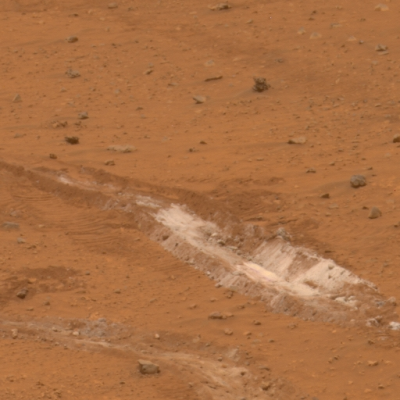29 May 2007

Credit: NASA/JPL/Cornell
An analysis of a patch of Martian soil performed by NASA's Mars Exploration Rover Spirit revealed rich silica content, providing strong evidence of ancient water activity on Mars. This silica deposit is believed to be the result of processes that require the presence of water.
During a recent teleconference, rover scientists reported that the alpha particle X-ray spectrometer, a chemical analyzer at the end of Spirit's arm, had measured a composition of about 90% pure silica for this soil sample.
"You could hear people gasp in astonishment," said Steve Squyres, Principal Investigator for the Mars rovers' science instruments. "This is a remarkable discovery. And the fact that we found something this new and different after nearly 1,200 days on Mars makes it even more remarkable. It makes you wonder what else is still out there."
The miniature thermal emission spectrometer aboard Spirit observed the patch, and Steve Ruff of Arizona State University found that its spectrum showed a high silica content. The team plans further study of the soil patch and surrounding deposits.
Previously, Spirit discovered other indicators of ancient water at its landing site, known as the Gusev Crater. These indicators include patches of water-bearing, sulfur-rich soil; alteration of minerals, and evidence of explosive volcanism.
"This is some of the best evidence Spirit has found for water at Gusev," said Albert Yen, a geochemist at NASA's Jet Propulsion Laboratory (JPL). Other explanations for the origin of silica could be the interaction of soil with acid vapors produced by volcanic activity in the presence of water, or from water in a hot spring environment. The new discovery is even regarded as strong evidence for ancient conditions that might have been favorable for life, according to investigators from the rover science team.
"What is so exciting is that this could tell us about environments that have similarities to places on Earth that are clement for organisms," said David Des Marais, an astrobiologist at NASA's Ames Research Center.
Spirit and its twin rover, Opportunity, accomplished their primary three-month missions in April 2004. Both are still operating, though showing signs of age. One of Spirit's six wheels no longer rotates, so it leaves a deep track as it drags through soil. That has exposed several patches of bright soil, leading to greatest discoveries, including this recent discovery.
The newly discovered patch of soil was nicknamed "Gertrude Weise", after a player in the All-American Girls Professional Baseball League, according to Ray Arvidson, Deputy Principal Investigator for the rovers.
"This unexpected new discovery is a reminder that Spirit and Opportunity are still doing cutting-edge exploration more than three years into their extended missions," said Doug McCuistion, Director of NASA's Mars Exploration Program. "It also reinforces the fact that significant amounts of water were present in Mars' past, which continues to spur the hope that we can show that Mars was once habitable and possibly supported life."
Spirit worked within about 50 meters of the Gertrude Weise area for over 18 months before achieving this discovery. "This discovery has driven home to me the value of in-depth, careful exploration," Squyres said. "This is a target-rich environment, and it is a good thing we did not go hurrying through it."
Further Reading
Mars Exploration Rovers
http://www.nasa.gov/mission_pages/mer/index.html
Aymen Mohamed Ibrahem
Senior Astronomy Specialist